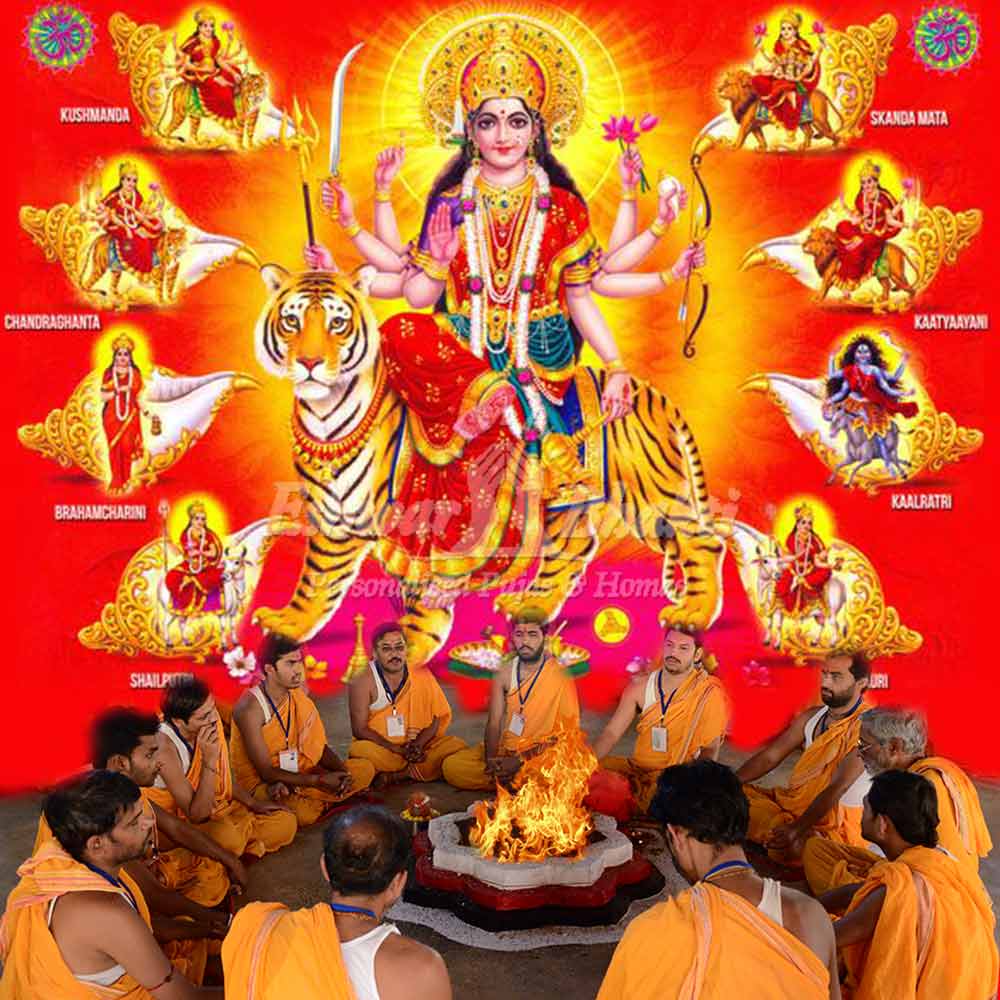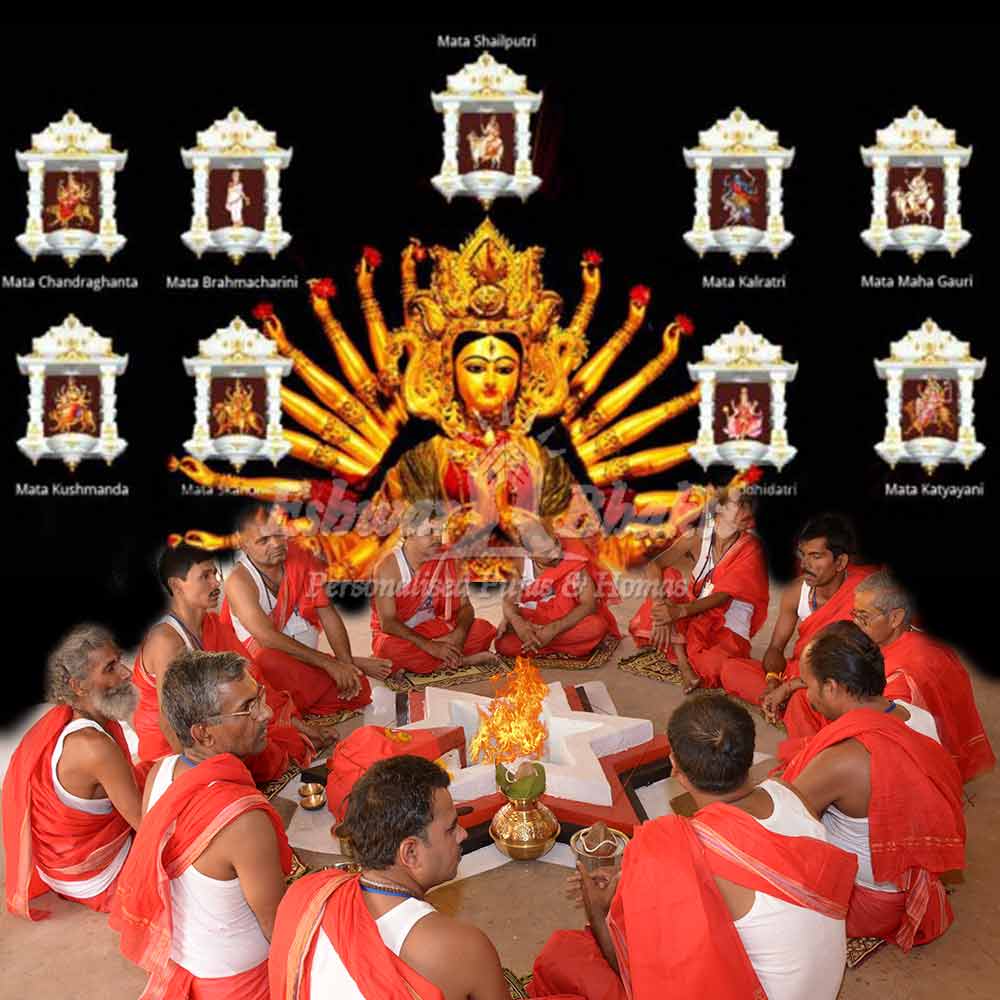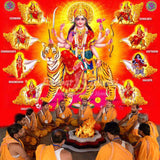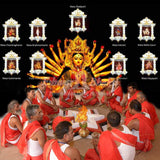





NavaDurga Puja & Homa
To invoke blessings of the nine forms of Divine Mother
- $3,363.00
- $3,363.00
- Unit price
- Fees: per
NavaDurga means Nine forms of Goddess Durga, the manifestation of Goddess Parvati in nine different forms. These nine forms of manifestation are Shailaputri, Brahmacharini, Chandraghanta, Kushmanda, Skanda Mata, Katyayani, Kalratri, Maha Gauri and Siddhidatri; together worshipped during the Navratri (Nine Divine Nights). Navdurga are worshipped during all Four Navratis in the year.
Shailputri: After the self-immolation as Goddess Sati, Goddess Parvati took birth as the daughter of Lord Himalaya. In Sanskrit Shail means the mountain and due to which Goddess was known as Shailputri, the daughter of the mountain. Goddess Shailputri is worshipped on the first day of Navratri. The Moon (Chandra), the provider of all fortunes, is governed by Goddess Shailputri and any bad effect of the Moon can be overcome by worshipping this form of Adi Shakti. She is also known as Hemavati and Parvati.
Brahmacharini: After Kushmanda form, Goddess Parvati took birth at the home of Daksha Prajapati. In this form the Goddess Parvati was a great Sati and her unmarried form is worshipped as Goddess Brahmacharini. She is worshipped on the second day of Navratri. Lord Mars (Mangal), the provider of all fortunes, is governed by Goddess Brahmacharini. During Her penance to get Lord Shiva as Her husband She spent 1000 years on the diet of flowers and fruits and another 100 years on the diet on leafy vegetables while sleeping on the floor.
Chandraghanta: Goddess Chandraghanta is the married form the Goddess Parvati. After getting married to Lord Shiva Goddess Mahagauri started adorning her forehead with half Chandra and due to which Goddess Parvati was known as Goddess Chandraghanta. She is worshipped on the third day of Navratri. The planet Venus (Shukra) is governed by Goddess Chandraghanta. This form of Goddess Parvati is peaceful and for welfare of her devotees. The sound of the moon-bell on her forehead expel all type of spirits away from her devotees.
Kushmanda: After taking form of Siddhidatri, Goddess Parvati started living inside the center of the Sun so that He can liberate energy to the universe. Since, then Goddess is known as Kushmanda. Kushmanda is the Goddess who has the power and capability to live inside the Sun. The glow and radiance of her body is as luminous as that of the Sun. She is worshipped on the fourth day of Navratri. She provides direction and energy to the planet Sun (Surya). It is believed that all the power to bestow Siddhis and Niddhis are located in her Japa Mala. She created the whole universe (Brahmanda), by just flashing little bit of her smile.
Skanda Mata: When Goddess Parvati became the mother of Lord Skanda (also known as Lord Kartikeya), Mata Parvati was known as Goddess Skandamata. She is worshipped on the fifth day of Navratri. The planet Mercury (Budha) is governed by Goddess Skandamata. Devotees who worship this form of Goddess Parvati get the benefit of worshipping Lord Kartikeya. This quality is possessed only by Skandamata form of Goddess Parvati.
Katyayani: To destroy demon Mahishasura, Goddess Parvati took the form of Goddess Katyayani. It was the most violent form of Goddess Parvati. In this form Goddess Parvati is also known as Warrior Goddess. She is worshipped on the sixth day of Navratri. The planet Jupiter (Brihaspati) is governed by Goddess Katyayani. She was born at the home of sage Katya and due to which this form of Goddess Parvati is known as Katyayani.
Kalratri: When Goddess Parvati removed outer golden skin to kill demons named Shumbha and Nishumbha, She was known as Goddess Kalaratri. Kalaratri is the fiercest and the most ferocious form of Goddess Parvati. She is worshipped on the seventh day of Navratri. The planet Saturn (Shani) is governed by Goddess Kalaratri. She blesses her devotees with Abhaya and Varada Mudras. Because of her Shubh or auspicious power within her ferocious form Goddess Kalaratri is also known as Goddess Shubhankari.
Maha Gauri: The Goddess Shailputri at the age of sixteen was extremely beautiful and was blessed with fair complexion. Due to her extreme fair complexion she was known as Goddess Mahagauri. She is worshipped on the eighth day of Navratri. The planet Rahu is governed by Goddess Mahagauri. Due to her fair complexion Goddess Mahagauri is compared with the conch, the moon and the white flower of Kunda. She adorns white clothes only and due to that She is also known as Shwetambardhara.
Siddhidatri: In the beginning of the universe Lord Rudra worshipped Adi-Parashakti for creation. It is believed that Goddess Adi-Parashakti had no form. The supreme Goddess of Power, Adi-Parashakti, appeared in the form of Siddhidatri from the left half of Lord Shiva. She is worshipped on the ninth day of Navratri. She provides direction and energy to planet Ketu. She is the Goddess who possesses and bestows all type of Siddhis to her devotees. Even Lord Shiva got all Siddhis by grace of Goddess Siddhidatri. She is worshipped by not only humans but also by Deva, Gandharva, Asura, Yaksha and Siddha. Lord Shiva got the title of Ardha-Narishwar when Goddess Siddhidatri appeared from his left half.
Puja service includes:
1st day puja: 9 Kalash Sthapana (one of each Goddess), Invocation of all forms of Durga, Panchang pujan, Shodas Matrika pujan, Sarvotabhadra, Gauri tilak mandal, 64 yogini Puja, Shetrapal Puja, 30,000 chants of Goddess Shailputri, Aarti, Pushpanjali.
2nd day puja: Panchang pujan, 30,000 mantra chants of Goddess Brahmacharini, Aarti, Pushpanjali.
3rd day puja: Panchang pujan, 30,000 mantra chants of Goddess Chandraghanta, Aarti, Pushpanjali.
4th day puja: Panchang pujan, 30,000 mantra chants of Goddess Kushmanda, Aarti, Pushpanjali.
5th day puja: Panchang pujan, 30,000 mantra chants of Goddess Skanda Mata, Aarti, Pushpanjali.
6th day puja: Panchang pujan, 30,000 mantra chants of Goddess Katyayani, Aarti, Pushpanjali.
7th day puja: Panchang pujan, 30,000 mantra chants of Goddess Kalratri, Aarti, Pushpanjali.
8th day puja: Panchang pujan, 30,000 mantra chants of Goddess Maha Gauri, Aarti, Pushpanjali.
9th day puja: Panchang pujan, 30,000 mantra chants of Goddess Siddhidatri, Dasang Havan of each Goddess, Aarti, Pushpanjali.
No. of priests: 9
Day: 9 days of Navratri
Eshwar Bhakti priests will perform your Puja as per the Vedic procedure. Please mention your birth details (name, date, time, and place of birth), & Sankalp (your wish) at checkout. This is an individual Puja (you may book puja only on your name or include your near/dear ones in your puja).
You can book this puja with or without a DVD. An hour-long DVD will have the main elements of your puja: Sankalpa, Abhishek or invocation mantras, presiding deity mantra chants, Homa and Aarti. If you opt for a DVD, we will upload it on a cloud link for you to download and watch online, within a week of your puja completion. If you don't opt for a DVD, we will email few short video clips and photos immediately upon successful completion of your ritual.
Performing your puja ritual with love and utmost care is our motto. We perform only Individual Personalized rituals. No group rituals. Here are the key steps to help you understand the process:
- You add a ritual to your shopping cart, after reading the benefits and based on your concerns.
- At the time of booking your ritual(s), you are asked to provide your "Name, birth details, Sankalpa and instructions" on the shopping cart page. You can also mention your Gotra, Nakshatra and Rashi details there (if you know).
- Immediately after the receipt of your order, we start identifying the most auspicious date and time to perform the ritual.
- An email is sent to you within 12 hours of order confirmation, which would comprise:
- Date on which your puja would be performed.
- Complete timings and duration of your ritual.
- Sankalpa time: When you can join us and pray for the fulfillment of your wish.
- Zoom meeting details for taking the Sankalpa.
- Mantra and meditation instructions to follow at your end.
- Dietary precautions on the day of your puja.
- List of some easy to get items, to take the Sankalpa.
- You can also email us your photo, at contact@pujayagna.com, to keep during the performance of your puja (optional).
- On the scheduled day and time, you can join over Zoom to take your Sankalpa (optional). You will be guided during the call to take the Sankalpa.
- Immediately after the successful completion of your ritual, an email is sent with photos/videos of the ritual.
- In case of rituals lasting over several days, you will receive daily updates over email, WhatsApp or Viber.
Have more queries, read Frequently Asked Questions.
 Related Pujas
Related Pujas
- From $3,363.00
- From $3,363.00
- Unit price
- Fees: per
- From $3,363.00
- From $3,363.00
- Unit price
- Fees: per
- From $3,363.00
- From $3,363.00
- Unit price
- Fees: per
- From $3,363.00
- From $3,363.00
- Unit price
- Fees: per
- From $3,363.00
- From $3,363.00
- Unit price
- Fees: per
- From $3,363.00
- From $3,363.00
- Unit price
- Fees: per
- From $3,363.00
- From $3,363.00
- Unit price
- Fees: per
- From $3,363.00
- From $3,363.00
- Unit price
- Fees: per
- From $3,363.00
- From $3,363.00
- Unit price
- Fees: per
- From $3,363.00
- From $3,363.00
- Unit price
- Fees: per
- Choosing a selection results in a full page refresh.




